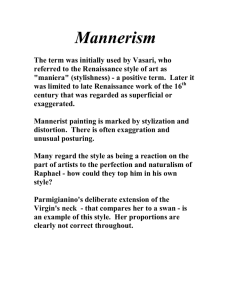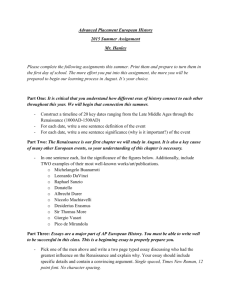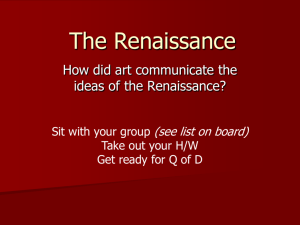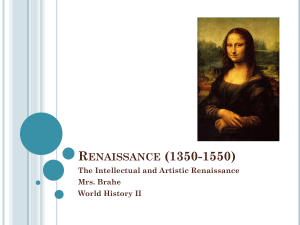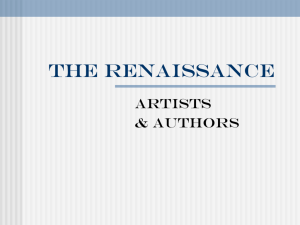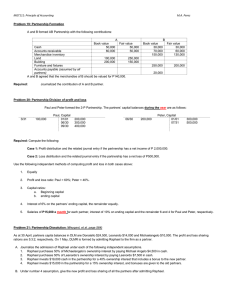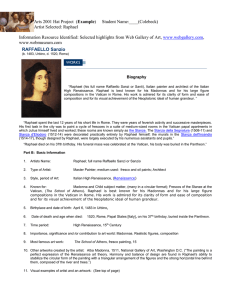File
advertisement
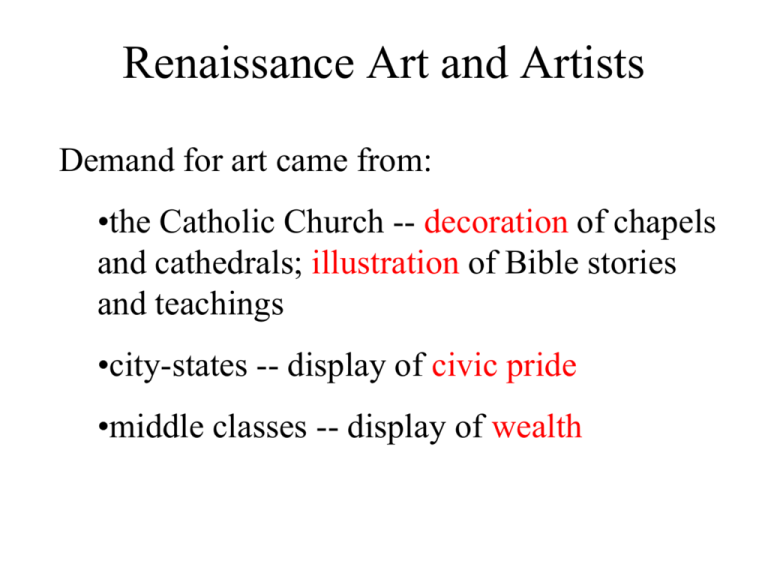
Renaissance Art and Artists Demand for art came from: •the Catholic Church -- decoration of chapels and cathedrals; illustration of Bible stories and teachings •city-states -- display of civic pride •middle classes -- display of wealth New mediums and techniques PAINTING •change from watercolor and tempera to oil paints •perspective -- illusion of 3-dimensional quality •chiaroscuro -- use of “lighting” effects SCULPTURE •return to “free-standing” statues •larger scales of sculpture and architecture WOODCUT PRINTS •allowed fine art to be mass-produced Subjects of Renaissance art RELIGION -- interpretations of Bible stories Madonnas -- images of Mary, mother of Jesus Pieta (Pity) -- images of the death of Christ saints and other religious figures HUMANISM -- Greco-Roman styles and stories allegories -- symbolic works portraits -- individual genre painting -- everyday life Andrea del Verrochio, Lorenzo de Medici (1474) Known as “Il Magnifico” (“The Magnificent”), Lorenzo was a major patron of the arts in his citystate of Florence. Michelangelo’s art career really began when he was invited to stay at the Medici palace while he practiced his art. Sandro Botticelli, The Birth of Venus (1485) Botticelli, A Woman is Received…(1483) Donatello, St. George (1417) Donatello is often given credit for reviving the free-standing statue as an art form. Donatello, Gattamelata (1448) Donatello, David (1452) •Today considered the artist’s masterpiece, for its time David was a very radical work: •The nude figure recalled classical Greek sculpture. However, Donatello doesn’t show David as a classical hero, but a contemporary shepherd, with the face and body of a young boy. •To many, this work represents Renaissance spirit in showing a confident, youthful human -- “the measure of all things” -- ready to face and conquer any challenge. Leonardo da Vinci, Mona Lisa (1504) Just why is Mona Lisa smiling? Just ask Dr. Lillian Schwartz... Leonardo da Vinci,The Last Supper (1500) Raphael, St. George and the Dragon (1505) This work represents much of the spirit of the High Renaissance: •Bright, bold colors •Man as the measure of all things Raphael, La Belle Jardiniere (1507) Madonna with the Christ child and John the Baptist…how does Raphael communicate the religious themes of this picture? Raphael, The School of Athens (1511) Raphael, Portrait of Baldassare Castiglione (1504) In what way(s) does this painting differ from the other works of Raphael that we’ve seen? Jan van Eyck, The Arnolfini Wedding Characteristics of Northern (German, Dutch, Flemish) Renaissance painting: •Realism in the extreme •Attention to details •Use of symbolism -- images that represent some other thing or idea A Young Hare (watercolor,1502) Self-Portrait at 28 (1500) Albrecht Durer The Four Horsemen of the Apocalypse (woodcut, 1498) Albrecht Durer, The Bagpiper (woodcut, 1514) (You can see what a Basic Design class did with this by going through the hallway to the 200s) Pieter Breughel, The Peasant Wedding (1528) Pieter Breughel, Hunters in the Snow (1565) Pieter Breughel, The Beggars (1568) Rembrandt van Rijn, Philosopher in Meditation (1632) Rembrandt van Rijn Self-Portrait (1630s) •Earthier tones (browns, blacks, etc.) •Realistic portraits Self-Portrait, 1660s Rembrandt van Rijn, The Three Crosses (etching,1653) Hieronymus Bosch Death and the Miser (1485) The Ship of Fools (1490-1500) Hieronymus Bosch, The Last Judgment (triptych), 1500s
